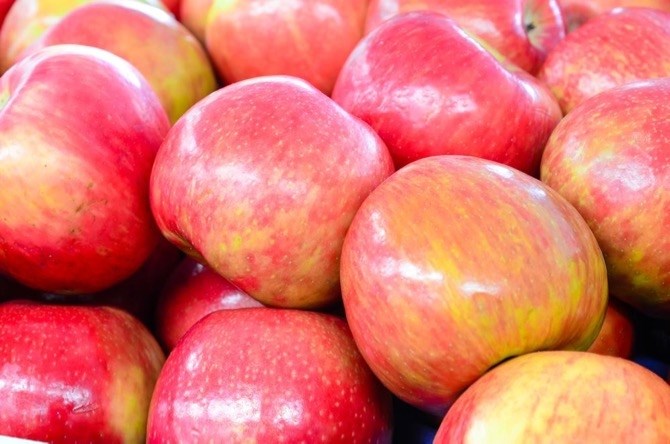
Ambrosia apples are number two in the Okanagan but closing the gap on Galas.
Image Credit: Contributed
October 24, 2018 - 8:00 PM
KELOWNA – Okanagan orchardists are just wrapping up what looks to be a bumper crop for apples this season.
“We didn’t get the intensive heat in September and October this year,” B.C. Fruit Growers Association general manager Glen Lucas told iNFOnews.ca. “When it cools off, that helps colour the apples and condition the apples, which makes sure they’re a larger size and crisper.”
If it’s too hot in the fall, as it was in 2017, the apples can actually stop growing. Smaller apples result in an overall smaller crop and lower prices.
Last year, the price to growers dropped from an average of about 25 cents a pound to 19. Those lower prices have persisted into this season but Lucas expects the prices to rise as the bigger apples start selling.
Four apple varieties make up about 80 per cent of the Okanagan’s 180 million pound apple crop with Gala by far the most popular at about 74 million lbs.
Rounding out the top four are Ambrosia (44 million lbs.), Spartan (16 million lbs.) and MacIntosh (15 million lbs.).
There are 15 varieties of commercially produced winter apples in the Valley, with the former champion, Red Delicious, down to about 9 million pounds (or 225,000 boxes weighing 40 lbs. each).
While Gala is king, Ambrosia is closing the gap.
“Ambrosia is fairly crisp, as firm or firmer than Gala and has the best shelf life of any of the apples out there,” Lucas said. “It doesn’t brown easily so it’s good for salads and it’s a good eating apple.”
While Gala originated in New Zealand, Ambrosia was an accidental discovery by Wilf and Sally Mennell on their Cawston orchard in the early 1990s. They found a tree growing and rather than pull it as a weed, left it to mature. The first year that it bore fruit, the picking crew ate the entire crop, which indicated they had something special.
Right now there are more Ambrosia plantings and more Ambrosia trees coming to maturity so it may some day take over the number one spot.
Not included in the list of commercial apples are summer varieties, like the Sunrise, that do not store so well so are usually sold locally.
“The Sunrise, has an odd characteristic in that it’s chill sensitive,” Lucas said. “If you buy it unchilled, it will last two to three or four weeks on the shelf. Put in the fridge and then put it on the counter, it will last a day.”
So, it must either never be chilled or, if chilled, eaten cold.
That’s in contrast to winter apples that are often chilled then left to sit for a few days on the counter waiting to be eaten.
Most of the Okanagan apple crop is sold in Western Canada and the U.S. but some are shipped overseas to markets in Taiwan and Vietnam. And some years there’s a good market in Mexico.
A few years back, there was a trade war over trucking services between Mexico and the U.S. so Mexico put a tariff on U.S. apples, opening up that market to Okanagan growers. That ended after awhile but seems to be heating up again.
There is free trade in apples between Canada and the U.S. so there was no impact from the new U.S. Mexico Canada Agreement.
Tariffs were imposed on U.S. apples about 25 years ago after the Americans were charged and convicted of dumping. Those lasted for about 10 years but were dropped,
While Lucas thinks the tariffs should still apply, Okanagan growers have responded by growing more Spartans and MacIntosh, which are not grown in the U.S. Plus, he says, we have the advantage of getting better colour on our Galas.
As for who is picking the apples these days, that has also evolved over time.
Over the years, waves of immigrants from countries like Portugal, India and Germany moved into Okanagan orchards and there was a large contingent of Indigenous pickers from Saskatchewan, central and northern B.C.
“The growers really liked the work the Indigenous workers did,’ Lucas said. “They were very hard working, very good with the apples. They didn’t bruise the apples. They were very efficient and very productive.”
But by the 1970s they were not coming any more. Lucas said they travelled with their families so more needs to be done to bring a family focus into play to possible attract those workers back.
There are still French Canadian students coming to the Okanagan but that’s more for the cherry crop, which is more labour intensive and finished by September when those workers return to school. While the cherry crop is about one-tenth the size of the apple crop by weight, it brings in slightly more revenue to the growers.
So far, the burgeoning cannabis industry hasn’t had any noticeable impact on the supply of pickers, Lucas said, but they are seeing some movement of management level people from greenhouses into the higher wage marijuana industry.
— This story was corrected on Oct. 25, 2018 at 11:45 a.m. to correct the name and title for Glen Lucas.
To contact a reporter for this story, email Rob Munro or call 250-808-0143 or email the editor. You can also submit photos, videos or news tips to the newsroom and be entered to win a monthly prize draw.
We welcome your comments and opinions on our stories but play nice. We won't censor or delete comments unless they contain off-topic statements or links, unnecessary vulgarity, false facts, spam or obviously fake profiles. If you have any concerns about what you see in comments, email the editor in the link above.
News from © iNFOnews, 2018